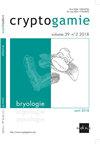Editorial Cryptogamie Joins the Museum Scientific Press
IF 0.9
3区 生物学
Q4 PLANT SCIENCES
引用次数: 0
Abstract
CRYPTOGAMIE, BRYOLOGIE • 2019 With this 40th volume, Cryptogamie enters a new era. The most far-reaching change is that Cryptogamie will be published online only and in fast track. Based on the concept that the journal should be freely available for both authors and readers, Cryptogamie has chosen the diamond open access model. At a time when the academic publishing system is more hotly debated than ever, this choice should offer to the community working on cryptogams the opportunity to disseminate research articles, without limitation, on a wide diversity of cryptogamic topics, with a strong focus on ecology and evolution and resulting systematic treatments. As editors of Cryptogamie, we are convinced that research on algology, bryology and mycology still has a long way to go. Even if overall estimates of extant species have tended to level off at around 10 million, the number of cryptogams (especially fungi) still to be described is so high that there is still no consensus in the community. In the context of the current erosion of biodiversity in response to global changes, the impact on cryptogams still needs to be evaluated at various levels, ranging from populations to ecosystems. In the era of high throughput screening, new techniques will most certainly improve our capacity to analyse the dynamics of cryptogam diversity. We sincerely hope that with this new publication model, Cryptogamie will play a full role in fostering our fields of study by disseminating high quality research articles. This transition to a diamond open access model is accompanied by the implementation of a new organizational structure. The title Cryptogamie is now owned by the Muséum national d’Histoire naturelle, an institution which has been disseminating scientific literature in the field of Natural and Human Sciences since 1802. The new mode of operating the journal under the auspices of the Museum Science Press should ensure that Cryptogamie continues to exist in the long term while respecting its guiding principles. Since its inception in 1980, Cryptogamie has been published by the Association des Amis des Cryptogames (Adac) to promote research on cryptogams. Strongly anchored in the Muséum national d’Histoire naturelle, Cryptogamie was nonetheless a journal open to a wide international authorship with a worldwide biogeographic coverage. It was often seen as complementary to Adansonia, a journal focusing on Pteridophytes and Phanerogamous plants distributed by the Museum Science Press. Now, thanks to a broadening of the editorial policy of the Museum Science Press to extend its scope beyond the collections of the Museum, and to promote the international influence of the Muséum national d’Histoire naturelle, it has been possible for Cryptogamie to be accepted among the periodicals distributed by Museum Science Press. The Association des Amis des Cryptogames, a non-profit organization, was created in 1979 by the researchers of the cryptogamic laboratory of the Muséum national d’Histoire naturelle, under the leadership of Professor Suzanne JovetAst, director of the cryptogamic laboratory, and Hélène Bischler, researcher at the CNRS. This initiative was taken to bring together into one title the journals published by different researchers in the laboratory: Revue bryologique et lichénologique, Revue algologique, Revue de Mycologie. Within Cryptogamie, each of the editors (Cryptogamie, BryologieLichénologie; Cryptogamie, Algologie; Cryptogamie, Mycologie) retained their independence while adopting common policies on the style sheet, the instructions to authors, and especially the process of peer review, respecting the International Code of Nomenclature for algae, fungi and plants. The wide focus of each section was preserved. The financial management of the three sections was the responsibility of Adac. In order to reduce the costs related to the composition of the articles, a workshop was created within the Adac to provide the commercial printer with print-ready versions. This mode of operation ceased in the 1990s, the composition of the articles being outsourced to the commercial printer. Technical and scientific management of the articles from submission to publication was managed by the editor of each section. The transfer of the title to the Museum Science Press will thus free the editors of technical matters which are not their primary concern. It will allow Cryptogamie to have greater international influence and a more secure future.编辑密码游戏加入博物馆科学出版社
CRYPTOGAMIE, BRYOLOGIE•2019随着这第40卷,CRYPTOGAMIE进入了一个新时代。最深远的变化是,cryptogame将只在网上发布,并在快速通道。基于期刊应该对作者和读者免费提供的概念,Cryptogamie选择了钻石开放获取模式。在学术出版系统比以往任何时候都更加激烈辩论的时候,这一选择应该为从事密码学研究的社区提供传播研究文章的机会,不受限制,关于广泛的密码学主题,重点关注生态和进化以及由此产生的系统处理。作为Cryptogamie的编辑,我们相信藻类学、苔藓学和真菌学的研究还有很长的路要走。即使现存物种的总体估计趋于稳定在1000万左右,但仍待描述的隐球菌(尤其是真菌)的数量如此之高,以至于在社区内仍未达成共识。在当前生物多样性因全球变化而受到侵蚀的背景下,仍需要在从人口到生态系统等各个层面对加密货币的影响进行评估。在高通量筛选的时代,新技术肯定会提高我们分析密码多样性动态的能力。我们衷心希望通过这种新的出版模式,Cryptogamie能够通过传播高质量的研究文章,在促进我们的研究领域发挥充分的作用。向钻石开放获取模式的转变伴随着新的组织结构的实施。Cryptogamie这个标题现在归mus um national d 'Histoire naturelle所有,该机构自1802年以来一直在传播自然科学和人文科学领域的科学文献。在博物馆科学出版社的支持下,新的期刊运营模式应该确保Cryptogamie在尊重其指导原则的同时继续长期存在。自1980年成立以来,Cryptogamie一直由Association des Amis des Cryptogames (Adac)出版,以促进加密游戏的研究。尽管如此,《Cryptogamie》仍然是一本面向广泛的国际作者开放的期刊,其内容涵盖世界范围的生物地理学。它经常被看作是《Adansonia》的补充,《Adansonia》是一本由博物馆科学出版社发行的专注于蕨类植物和异生植物的杂志。现在,由于博物馆科学出版社扩大了编辑政策,将其范围扩大到博物馆藏品之外,并促进了mus um national d 'Histoire naturelle的国际影响力,《Cryptogamie》已经有可能被博物馆科学出版社发行的期刊所接受。密码游戏协会是一个非营利性组织,于1979年由国立自然历史博物馆密码实验室的研究人员在密码实验室主任Suzanne JovetAst教授和法国国家科学研究中心的研究人员h2013.ne Bischler领导下创建。这一倡议的目的是将不同研究人员在实验室发表的期刊集中到一个标题中:苔藓学和lichsamnologique、演义学和菌学。在Cryptogamie中,每一位编辑(Cryptogamie, bryologie;Cryptogamie Algologie;Cryptogamie (Mycologie)保留了它们的独立性,同时在样式表、对作者的说明,特别是同行评审过程中采用了共同的政策,尊重藻类、真菌和植物的国际命名规则。每个部分的广泛焦点都被保留了下来。三个科的财务管理由Adac负责。为了减少与文章组成有关的费用,在Adac内设立了一个讲习班,向商业印刷商提供可印刷的版本。这种操作模式在1990年代停止,文章的构图被外包给商业印刷商。文章从投稿到出版的技术和科学管理由各科编辑负责。因此,将标题转移到博物馆科学出版社将使编辑从他们不主要关心的技术事项中解脱出来。它将使cryptogame拥有更大的国际影响力和更安全的未来。
本文章由计算机程序翻译,如有差异,请以英文原文为准。
求助全文
约1分钟内获得全文
求助全文
来源期刊

Cryptogamie Bryologie
生物-植物科学
CiteScore
2.10
自引率
25.00%
发文量
12
审稿时长
3 months
期刊介绍:
Cryptogamie is a fully electronic journal, with a continuous
publication stream, devoted to a wide diversity of cryptogamic
topics, mainly in the taxonomic-phylogenetic field.
Cryptogamie, Bryologie accepts articles on systematics as
well as ecology and evolution of all of bryophytes.
Thematic issues may also be published under the responsibility of a guest editor.
 求助内容:
求助内容: 应助结果提醒方式:
应助结果提醒方式:


